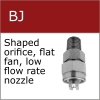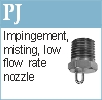Spray reach for disinfection applications
When conducting a disinfection operation, the main job of the spray/fog nozzle is to ensure that the disinfectant reaches the target surface or air space. For sanitising chambers or conveyor based sanitising processes, reach can normally be achieved from
direct line of sight of the nozzles. The system will be designed such that the nozzle system will be able to directly target all parts that need disinfecting. For larger, room sized applications other methods of reaching all areas may be required.
Fogging

When we achieve a low droplet size (sub 40 microns) the spray becomes highly suspended in the air and will move around in air currents This can help carry the spray to places beyond the direct line of sight of the nozzles. Of course, this same phenomenon
may also be problematic if the disinfectant needs to remain in a discrete area.
The rapidity of distribution by air currents will depend very much on the natural air movements within the areas. Natural air movement can be improved with the use of fans to help distribute the fog/mist. Also in air atomising nozzles the fluid will be
projected quite far from the nozzle, much further than high pressure misting nozzles, and so the use of these nozzles will help greatly with initial fluid distribution.
The droplet size will also be an important factor. Not all fogs are equal. Fogs/mists with droplet sizes in 20–40 micron range will settle out of the air more rapidly and, hence, will require swifter distribution to get to the target areas. 10-20
micron fogs will remain airborne for much longer and so can be distributed more slowly and still be effective at reaching difficult areas. Sub 10 micron fogs tend to remain airborne for very long periods of time without much settling so will, over
time, naturally distribute to fill an entire air volume. However, this does need to occur before complete evaporation occurs so the length of time available is not infinite.
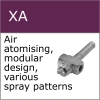
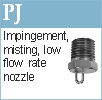
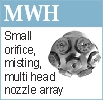
Direct spraying
 When spraying in a sanitising spray chamber/ conveyor the problem of reach is solved by bringing the target to the spray. Similarly, when sanitising is delivered
by a mobile operator the reach problem is solved by bringing the spray to the target. As such, even large areas or multiple targets can be treated with short range sprays.
When spraying in a sanitising spray chamber/ conveyor the problem of reach is solved by bringing the target to the spray. Similarly, when sanitising is delivered
by a mobile operator the reach problem is solved by bringing the spray to the target. As such, even large areas or multiple targets can be treated with short range sprays.
This means that sprays with larger droplets and minimal air distribution can be used for these applications. Indeed, in many situations the spray needs to remain confined to a discrete area and so sprays with very small droplets that are likely to waft
off target with prevailing air currents are not desirable. That being said, very large droplets may not provide adequate coverage or will give excessive and undesirable wetting. So, a happy medium is often ideal.
Typically, in spray chambers a fine mist/wet fog is the most desirable spray. As the area being filled with the mist is small and close to the nozzle we do not need to worry too much about reach from the nozzle so secondary movement processes like fans
are generally not required. This means that simple hydraulic nozzles as well as air atomisers can be used. Additionally, If the target is complex in shape with areas that are not in direct line of sight of the nozzles, then a small drop size below
40 microns is required as this will allow air movement to move the fine spray to areas that cannot be sprayed directly.
